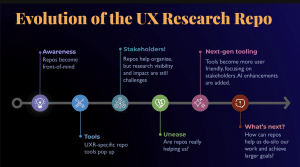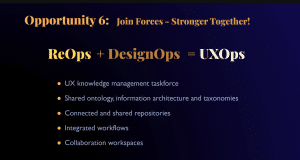Day 2 Session Notes–Stronger Together: Lessons Learned from UX Research Ops

— Thank you and welcome to talk and tuning in

— Emily: Background in research as ethnographer for many years and became archivist and know knowledge management in UX
— Maria: CEO and COO and working at intersection of DesignOps and ops support each other effectively and help other companies build sustainable operational capacity

— Both live in Front Range of Colorado and met at in-person UX event and started talking about knowledge management
- Overview and interest in topic and lessons learned in research operations and opportunities for UX ops and what future look like

— Common goals and challenges across ops
- Communication: Often have to decide who needs what level of detail for different people
- Collaboration: Who to work with
- Process: Efficient while navigating shifting contexts of research and design
- Tooling: How to leverage for best results
- Accountability: More today
- Knowledge Management: Knowledge standards for research output
— You are a knowledge steward, whether you think you are or not

— Two types of knowledge
- Explicit Knowledge, what can be codified
- Implicit Knowledge, skills people have and carry with them
— Two types of explicit knowledge
- Static: Don’t change often but easily referenced
- Dynamic: Type of knowledge that evolves frequently and different information types or asset types
— Helps as we need different types of solution for types of knowledge

— A quick overview of the evolution of the research repository
- From perspective having worked in field since 2021
— Awareness:
- Repositories have become front of mind, and research we have done in past
— Tools:
- UX specific repository tools like EnjoyHQ and Aurelius to manage knowledge base
— Stakeholders:
- UX specific repositories helped organize research, but visibility still was challenge, with limited stakeholder adoption
— Unease:
- Unease around repositories and if they helped overall mission
— Next-Gen Tooling:
- Tools become more user friendly with AI enhancements and more user friendly UI
— What’s Next
- How can repositories de-silo UX work and achieve larger goals

— From 2021 to present worked with a few companies and research repositories
- Lessons applicable to today
— Don’t decide on solution before you understand problem space
- All teams I worked with on knowledge management recognize things were more complex than what team realized
- Overlapped with communication problems

— We need to practice UX we preach, in how processes developed alongside with team, and UXR teams are often choosing a tool before thinking of end-users and stakeholders
- Because of time constraints, often had problem where repositories were only for researchers and not stakeholders
- So these repositories often failed

— Lesson 3: Separate goal of asset organization, versus insight sharing
- Without skillset, people think tool will solve problems, but if teams didn’t dive deeply into tooling goals
- Two goals are conflated together and strategy that didn’t work well

— Not all learnings are captured and reviewing what was going into research repositories
- Reports don’t capture everything and risk of fallen fruit of lost insights that weren’t or couldn’t be captured

— Lesson 5: Repository wasn’t solution, but knowledge management was
- Librarians and archivists have been doing this task for many years
- Archivists evaluate whole collection of rare material, describe it, and evaluate significance of it, and a system to organize it
— Each step along way, in service of access to material

— Our takeaways
- Need for strategic repository planning, to prevent siloed UX practice
- Design and research knowledge are not treated as business assets

— We’ll do a deep dive into what assets look like and framing UX assets as business assets
- Looking at opportunities for improving research and design knowledge management
— UXers produce outputs for end product and feel value only recognized as end product itself
- Start with what UXers produce as business asset
- Valuable resource used to run the business
— Customer data and software and UX assets and connection between how they roll up, and research insights and templates and workflow
- Many key outputs are valuable resources that contribute to business success
- This perspective changes on how we can use them

— So how to manage knowledge?
- Different knowledge requires different types of KM solutions
— UX assets require own specific information management solution, of using assets for business products and services
- In information management system, visibility across all assets in system and direct traceability and properties for using assets

— Next opportunity for meaningful connections for different types of knowledge to get things we need and stronger scaffolding
- Connective tissue and taxonomies and contextual and relational schemas
— UX assets as findable and managing assets themselves, through content organizing structures, and connect knowledge types together

— We can then produce design intelligence with how to analyze design data, and produce actionable information to make informed business decisions
- Missing layer of business intelligence function

— What does design intelligence do?
- Better transparency and traceability and track assets across organization
- Opportunities for cost reductions and manage compliance and reporting
- Tool for scaling UX practice and any kind of ebb and flow

— Different roles need different slices of information and context from Design Intelligence
- VP of design needs specific info compared to an individual contributor
— Success requires intelligence for all roles and stakeholders in UX process

— To take advantage of opportunities, need an integrated UXOps model for BusinessOps and ProductOps
- Shouldn’t be contributing to silos of information
— Create joint task force and collaboration spaces, and maintaining connective tissue
- Keep tool and connective tissue accurate, so business process automation can help a lot
— Need to recognize learnings discussed

— Lessons learned
- Practice UXR internally and be clear on goals and requirements of a repository
— Opportunities
- UX assets are business assets and manage UX knowledge and assets
- Enable design intelligence and support multiple use cases
- Have DesignOps and ReOps join forces

— Reframe value proposition for practice of UX for better and more intelligent tooling
- Integrate operations and successful tri-track delivery
— Knowledge stewardship and shared responsibility
— Knowledge as visible, organized, and accessible

— End with a few visuals to bring things together and continuous research going into continuous design and development
- Left is demonstrating and different UX discipline areas and aligning with DevOps and working with ProductOps
— Adopt and evangelize delivery model

— VP of design rolled out unified approach and what mockup of what intelligence solution could look like for a VP of design
- Drill into more info for specific products at high-level view of assets across functional area
- Also showing heat-maps across different assets
— Assigned work related to functional area, can see team assignments
- Sense of mess and sprawl across ecosystem and arms around solving problem
- Use tool like this today, and underpinning of it for different dashboards

— Let’s end with simple image of a tree with lots of knowledge apples on it, and seeing it as visible and organized

— Thank you all, and hope it gave pivotal assignment for role of UX strategy to elevate our practice together
Q&A
- Are design intelligence and design intelligence management singular items or should each function involve some kind of business intelligence function such as finance, marketing?
- Other parts of business have built-in business intelligence tooling in place, but relatively new for UX to include
- Business intelligence missing our pierce of design intelligence
- Other parts of business have built-in business intelligence tooling in place, but relatively new for UX to include
- What is ROI of doing this?
- First say that yes, companies are more willing to throw money at tool versus expertise
- Find knowledge eco-systems first and then build upon that
- In terms of ROI for knowledge management— it just takes start-up time
- We do search and find for items multiple times a day
- Concept of ROI is something in field, but practices of BI and KM have established ROI, so we need to bring it to our part of organization
- All about maturity arc, and if org is ready to take challenge of KM on
- Have you hit resistance from design side connecting to business assets?
- Yes, but only in sense that job was something new, but using the tool resolves the concerns
- Requires as mindset shift to get into business asset frame of mind

